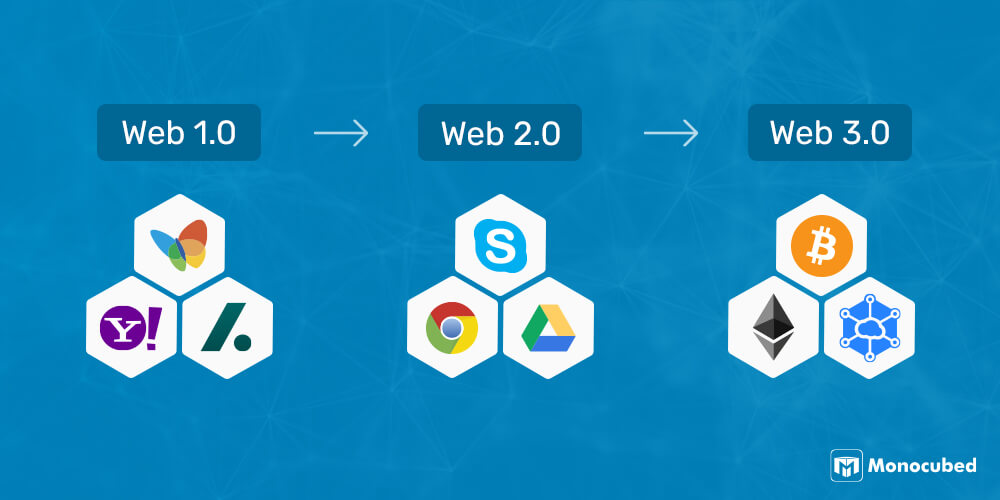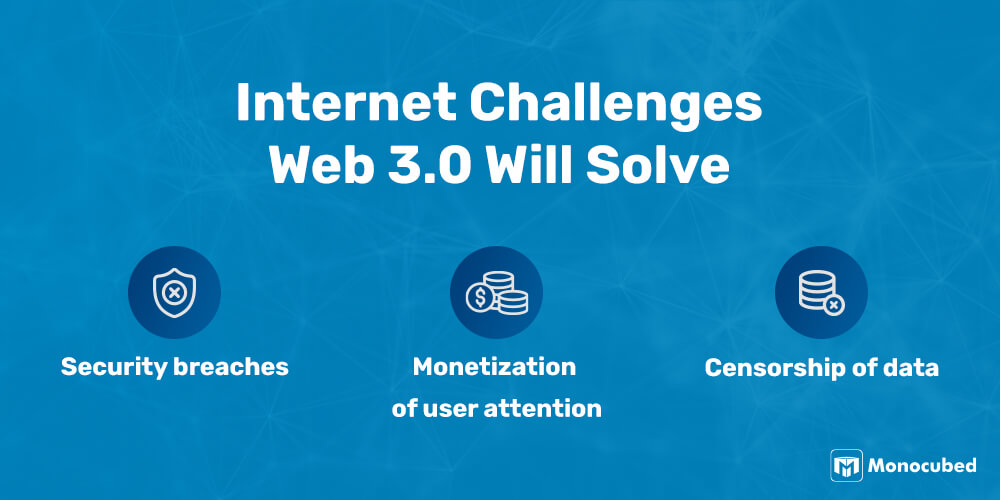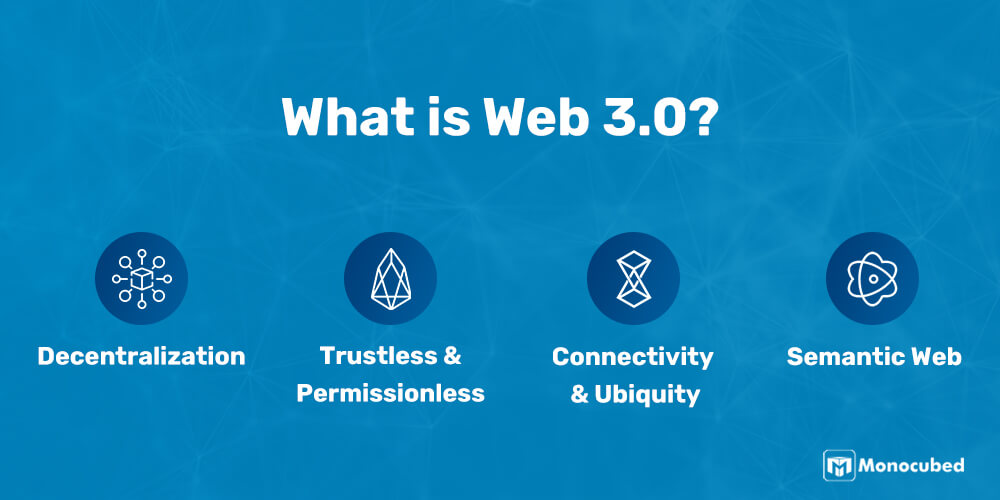Discussions about Web 3.0 have taken social media by storm. Everyone on Twitter and Reddit is talking about buzzwords like ‘Web 3’, ‘NFTs’, and ‘dApps’.
But what do these words mean?
What is web 3? When is it going to release? How does it affect everyone?
We are here to clear all this confusion in your head. In this blog, we discuss everything about Web 3.0 – its definition, its features, why we need it, and all the problems it will solve.
So let’s dive in!
Table of Content
To be clear, the world has not yet entered Web 3.0.
We are still using Web 2.0 and will continue to do so for some time. But with the advances in NFTs and cryptocurrencies, we are on the cusp of the new era of the internet.
Right now, all the data on the internet is owned by third-party organizations. For example, any posts you make on Twitter, are owned by the company. They can access it, edit it or delete it (as seen by deleting Trump’s tweets for racist content.)
The new and improved Web 3 aims to make the internet more open source. It will allow all the data – images, GIFs, reels, music – to be owned by the community. This will minimize hacking, data leaks, and censorship.
So let’s start by understanding what Web 3.0 actually is.
What is Web 3.0? [Web 3.0 Definition]
In the simplest terms, Web 3.0 is the third version or third iteration of the internet. It is a collection of ideologies and principles that makes the internet’s data accessible to users and creators. The core concepts driving the 3rd iteration of the web are decentralization, transparency, and user utility.
To understand web 3.0, let’s look at these defining features of Web 3.0 are –
Decentralization
This is the main feature of Web 3.0. The whole internet will be decentralized.
Right now, all the databases and apps are hosted on centralized servers. Like the Facebook app and all its data is on the central Facebook server, which is owned by a single organization.
But with Web 3.0, the apps will be hosted on blockchains and decentralized data networks. That means you can host a web app on your own decentralized network, and it will function just well.
Such apps that are hosted on peer-to-peer networks or servers are called dApps or decentralized apps. There will be no central authority that has control over who can access the apps or the data in it.
Trustless and Permissionless
Blockchain is a huge aspect of Web 3.0. Developers are using blockchain to create open and transparent data stores, which will usher in the 3rd generation of the internet.
With blockchain, all the data exchange and transactions that take place will be secure and transparent. The copies of the data store will be on each system (PC) that are in the decentralized networks.
So anyone on the network will be able to access and modify the data. You do not require any central intermediate party who will authorize the data access. There will be no single organization that can obstruct data or show any bias towards any user. All the data is secured by the network itself and available to all without requiring any permissions.
Thus the data will be trustless and immutable – meaning any change in the data will be automatically reflected in all the copies in all the systems on the server.
Connectivity and Ubiquity
Web 3.0 will be more connective and ubiquitous. Meaning the web will be everywhere. Smart devices will keep the people constantly connected and accessible to the internet. This is already a possibility with the Internet of Things (IoT) giving us smartwatches and driverless cars. But Web 3.0 aims to connect to everyone across the world without any software or hardware limitations.
Semantic Web
The internet of today understands the syntax rules – the grammar. But in Web 3.0, the internet would understand semantic rules too. This would be possible through advances in artificial intelligence and machine learning.
Semantic web was the original idea of Web 3.0. According to Tim Berners, the creator of the internet, Web 3.0 would be able to understand human languages. The computer would be able to process the context, the emotion, the implications, and the slang that makes up a human language.
Before we discuss each of these principles in detail and how the current internet version stands, let’s look at the history of the web.
Evolution Timeline of World Wide Web
The evolution of the internet has been exponential. During the early days of the internet connection, no one thought that it would be possible for people to visit places virtually or have a smart refrigerator.
The internet is widely divided into versions or phases –
- Web 1.0
- Web 2.0
- Web 3.0

But there are no exact dates we can point to and say, this is when we upgraded from Web 1.0 to Web 2.0 version. Why not? Because each Web version is a collection of ideas about how data is stored, how users interact with the internet and accessibility.
Let’s look at Web 1.0 and Web 2.0 in brief, before we understand how Web 3.0 will be different.
Web 1.0 – The Read-only Web
The World Wide Web was designed by Tim Berners-Lee in 1990. The internet was highly specialized at the time, mainly used by researchers and scientists.
But with the development of browsers (Internet Explorer), the web became available to the general public. And thus Web 1.0 was born.
Web 1.0 is the first iteration of the World Wide Web between the mid-1990s to 2004. During this time the web was mainly one-dimensional. Users just read data. The websites mostly had static web pages providing information. Most of the users did not create or share any information.
There were some users (say 1 in 1000) who hosted personal web pages but other readers couldn’t leave comments or interact with the author. The functionalities were limited.
Plus all the data was stored in the server’s file system instead of a database. This means the web was decentralized. It was powered by the personal computer of Berners Lee.
The web was available to all. But it required a lot of technical proficiency to use it to make content. To make the internet easy to use for everyone, new sites and platforms started to evolve by the early 2000s. These platforms made the internet truly available to everyone around the world.
Web 2.0 – The Social Web
Web 2.0 emerged somewhere around 2004 -2005. And we are still using this iteration of the web.
How was Web 2.0 different from Web 1.0?Web 1 was about gaining information. Web 2 is more about exchanging information. The internet became more simple to use, more accessible to the common folks and worked on multiple devices after the invention of smartphones.
With the emergence of websites like Google, Amazon, and Facebook, the internet became even more interactive and social. People started exchanging stories and connecting to people across the world.
Soon, with the development of smartphones and tablets, mobile internet access was available to people. Now the internet was full of user-generated content. Anyone could share information because the internet had become easy.
This was possible due to the centralization of data. Earlier, during the time of Web 1.0, the web data was stored on personal server filesystems.
With so many internet users, the data became too huge to maintain and a centralized database system was devised. So now, every post and profile on Facebook was stored on Facebook’s central server. Thus, all the data became organized and more importantly, dynamic. Meaning people could easily interact with the web by commenting, sharing, liking, and poking.
Additionally, it became more accessible. Be it a desktop, laptop, smartphone, or tablet, users could access various social media platforms, websites, and apps.
Web 2.0 transformed users into creators. Anyone could create a vine or post a video or host a server.
Today, web 2.0 is still going strong. There are millions of apps and websites, each trying to outperform the other.
Have A Web App Idea in Mind?
Contact us to get a one-of-a-kind web solution for your business. We will help you validate your idea and provide a free personalized quote.
But there are problems with Web 2.0 as well. And this is why we need a new iteration of the internet.
Why We Need Web 3.0 – Internet Challenges to Overcome

In 2019, there was a Web 3.0 Summit – a conference of researchers and engineers to find out where the internet is going and what Web 3.0 will look like?
It was clear – Web 3 will be decentralized. Why? Because the internet is not working anymore. The way the internet is right now, there are numerous problems. In fact, the inventor of the web, Tim Berners-Lee himself talked about what’s going wrong with the web at its 30th anniversary.
The three main problems of the web according to Tim Berners-Lee are –
- Security breaches – hacking, selling of user’s personal data, and intentional security attacks
- Monetization of user attention – advertising, clickbait, and spread of misinformation for money
- Polarized online discourse
The third problem is out of scope for this blog. But we will discuss the first two problems in detail and then talk about how the decentralized Web 3.0 will solve them.
Security Breaches
The security of users’ data is a huge problem today. If the central server is hacked or compromised, all the data stored in it could be leaked or changed. And this has happened – 533 million Facebook users’ data leaked!
Another problem – Surveillance
Major companies and organizations like Google are constantly collecting user data. They then sell this user data to ad agencies and other companies. While this contestant data collection helps provide users with more targeted and personalized content.
At the same time, it is also unfair and can lead to a lot of security and privacy issues as we discussed earlier.
Monetization of User’s Attention
Since its inception, the Web has been open-source and freely available to everyone. But this meant there was no specific way to generate revenue from it. One of the only ways was online advertising.
But over time, advertising has transformed into monetizing users’ data. Websites analyze users’ data and provide personalized advertising. But most users use ad blocks and the companies are no longer profiting as much with online advertising.
Why?
Attention scarcity.
With the various apps and websites battling for your time, users have limited time and they have to decide where to focus their attention. Should you watch the next episode of a Netflix show or scroll Instagram or make a TikTok or discuss on Twitter?
There is a scarcity of attention, and the internet has become an economy for monetizing users’ attention and time. Web developers and marketers are constantly trying to find new ways to grab and retain your attention. They spend millions of dollars for it but most of them do not earn it back.
Another major disadvantage that we did not foresee – the ownership of the data.
Censorship of Data
When you post something on the internet, the content is no longer in your hands. Anyone can reuse and recreate your content.
Ownership of data is a huge issue of Web 2. For instance, all the revenue generated by the posts on a social media platform goes to the company behind it. Because technically, they own all the data. So a song cover you post online or a reel that gets 10K views on Instagram, all the money from it goes to the platform. Even though the content was your creation. Of course, platforms like YouTube do pay the creators but the company still retains a large percentage of the earnings.
All of these are only the major problems of the present internet. Therefore, it is very important that a new iteration of the Web is evolved which can solve these problems.
Let’s see how Web 3.0 is supposed to work and solve the mentioned problems.
How Will Web 3.0 Help?
The main feature of Web 3.0 as discussed is decentralization. With Web 3, we will have to see the following changes –
- All the data will be indestructible and traceable
- Users will have more control over ownership of their data
Indestructible and Traceable Data
With Web 3 being decentralized, all the data will exist on multiple blocks. Whenever something is updated, all the copies of that data on all the different servers will be updated simultaneously. When we say multiple blocks, we mean thousands and thousands of systems will store the same data.
Thus, the data is virtually indestructible. Even if someone tries to erase or change the data, the other copies will remain.
This removes the two main problems we have of the internet right now – surveillance and censorship issues.
Users Have Ownership of Data
Here the concept of NFTs comes into play. NFT or non-fungible tokens are non-replaceable tokens. They can represent any digital data – videos, memes, gifs, music, drawings, etc.
You store the digital data in the NFT along with the ownership details. So while people can download and reuse that meme thousands of times, the original artist (or the person who buys the NFT) will be the owner. They can even get a share of the profits every time the art is downloaded or shared.
Blockchain will simplify ownership control as all the records are transparent and easily accessible.
Apart from these, there are numerous advantages of Web 3.0. Semantic web envisioned in Web 3 will result in intelligent search engines, numerous smart devices in our house connected to the internet, and secure money transfers online through browsers. It is an exciting time as developers and engineers worldwide try to create new ways to advance the internet.
Here are answers to some common queries about Web 3.0.
Frequently Asked Questions
What are examples of Web 3.0?
There are already a lot of organizations and developers who are working on Web 3.0 or the semantic web. Although it will still take some years to bring Web 3.0 fully, there are some applications and browsers that are already implementing the decentralized protocols. Examples are Metamask, Brave, MyEtherWallet, and Coinbase.
Is Web 3.0 good?
Yes. Web 3.0 is the next step in the technological innovation of the web. It tries to solve many of the problems we are facing with the current version of the internet such as loss of privacy, targeted advertising, central control, and censorship. While Web 3.0 also has some of its own challenges, it is the right step ahead.
Conclusion
This guide on Web 3.0 has helped you understand the meaning behind all the buzzwords like NFTs and decentralized web.
Cryptocurrencies are just the first step in revolutionizing the web. With dApps and other new technologies, Web 3.0 will bring in a more fair and accessible internet to the users.
As a web development company, we are extremely excited by all the new changes happening in the web world. Subscribe to our newsletter to get regular updates on our technological blogs.
 By Jeel Patel
By Jeel Patel



